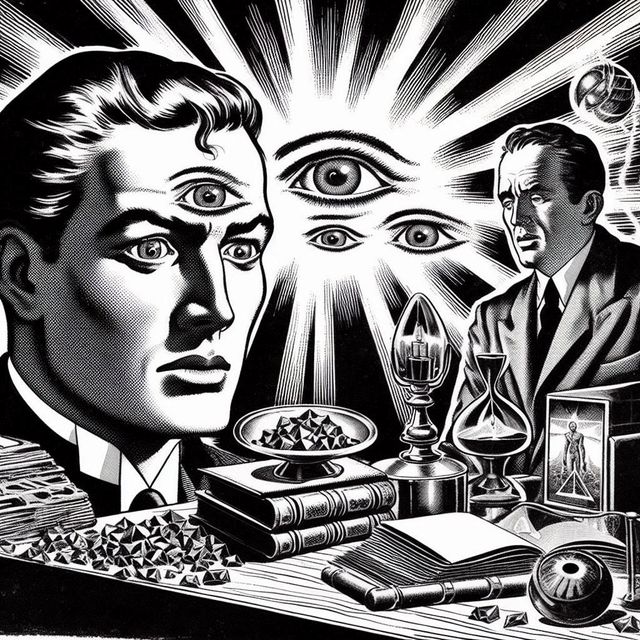-
Vijay Fafat
- Published on
A fairly minor story of no consequence. The one small mercy is that the outlandish occurrence is dismissed as a hallucination of someone undergoing an eye operation. The little yarn is based on the thesis that if one eye can only see two dimensions, without accurate depth perception, and a third eye adds the perception of the third dimension, then clearly adding a third eye should let you see into the fourth dimension (likely when the reader rolls that third eye…). In the process, standard geometric explanation of spatial dimensions is expatiated upon. Some excerpts:
“I ain’t sayin’ it is—I’m tellin’ you what he said. With one eye you can only see things in two dimensions. That’s what he said.” “You’re right, lake,” agreed the second man. “That’s what he said.” Tubby relaxed hopelessly. “Well, it ain’t so. Bunk. Absolutely bunk!” The first man was unabashed. “Well, that’s what he said. A one eyed man secs everything flat. Length an’ breadth, but no thickness. A world of only two dimensions.”
[…]
The professor paid no attention to the interruption. “I must explain about dimensions first. We are living, you understand, in a world of three dimensions.” “length, breadth, an’ thickness,* Tubby elaborated promptly. The professor beamed. “Precisely. You have a scientific mind. I knew you had. Now to proceed. What is it has location, but no dimensions ?”
“Search me,” said Tubby.
“A point. And what has one dimension ?”
Tubby wrinkled his forehead, struggling to think. “I give it up,” he declared finally. “You tell.”
“A line,” said the professor. “A line has only one dimension—length.” “So has time,” suggested Tubby.
The professor smiled. “You will have your little joke, I see. You’re a clever man. I like clever men.”
“Right,” said Tubby. “Go on to two dimensions.”
“A square has two dimensions—or any plane figure. Also a shadow. And you and I have three dimensions—also almost everything else in the world about us.”
Tubby nodded. “A taBle, for instance.” —
“Yes a table. Now that brings us to the theory of stereoscopic vision. You understand that with one eye we can see only two dimensions—length and breadth, but no thickness. To put it more technically, with one eye there is no depth to the field of vision. The scene might just as well be painted on a piece of canvas. It is a little difficult to distinguish the difference at first, because if you painted a scene in perfect perspective, life size and in full natural colors, even on a flat canvas it would look very realistic. There is a very great difference, however.
[…]
He held a little cube of sugar a few inches from Tubby’s eyes. “When you look at that with only your right eye, you sec the front face and part of the right side. Is that so?’’ Tubby tried it, and nodded. “And with the left eye alone, you also see the front face, but instead of the right side you now sec part of the left side. Do you?” “No—yes,” said Tubby. “Sure I do.” “Very well. Now, with two eyes you combine both of those images. Your eyes sec the object from different view points. Look now with both eyes. Now you see the front face of the cube and partially around both its sides. That is what gives you the third dimension—it is what makes that cube look solid. With one eye it merely looks like a picture of a lump of sugar—a flat picture, printed on a flat page.
“It is the combination in your brain of the different images your left and right eyes see that gives you a perception of our world of three dimensions. Is that clear *” “Absolutely,” declared Tubby. “Very well. Now listen carefully. One eye gives two dimensions. Two eyes give three dimensions. And then three eyes—” The professor paused expectantly. “Three eyes—” prompted Tubby breathlessly. “Why, three eyes give four dimensions,” said the professor triumphantly. “With three eyes rightly equipped you can see that other world lying all about us—that other world science has been trying for so long to discover— the world of the Fourth Dimension! ”
